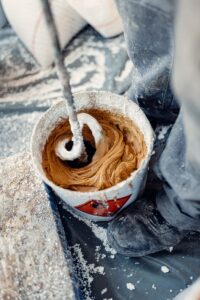
Lafayette 337-329-8445
New Orleans 504-229-2083

Lafayette 337-329-8445
New Orleans 504-229-2083

So the color in your office is driving you crazy and it’s time for a change! You traipse on down to your local hardware store, and ask how much paint you need for a 15′x17′ room. You pick a color, grab a couple of cans, head back, and start painting. As you finish the first coat, you notice you still have tons of paint! But when the walls dry, you can see straight through the color! Why? The answer, is paint viscosity. The thickness of a paint contributes to a lot of factors. And if you don’t have the correct paint for the job, it can turn your one coat job into four coats.
The easiest way to explain paint viscosity is to compare it to common things. Think about water. It runs, beads up, doesn’t leave a residue, and is a “thin” liquid. Now think about milk. It’s a bit thicker, flows a little slower, leaves a slight trail, but it’s pretty thin too right? Now imagine maple syrup. It’s a thick, very slow moving liquid that leaves behind a lot as it spreads.
If you apply these factors in terms of paint, it suddenly makes sense how one paint can do the job in one coat, while others take several. A thinner paint doesn’t leave much behind when you spread it, so it requires multiple coats. Thicker paints go on and typically don’t need more than one or two coats.
 An important thing to keep in mind as you paint shop are your tools. Will you be using a brush and roller? If that be the case, go for the thicker paint. It will save you time and money – because you’ll be done faster. If you’re using a paint sprayer, you need thin paint. Think about a water gun. Now fill it with syrup.
An important thing to keep in mind as you paint shop are your tools. Will you be using a brush and roller? If that be the case, go for the thicker paint. It will save you time and money – because you’ll be done faster. If you’re using a paint sprayer, you need thin paint. Think about a water gun. Now fill it with syrup.
Do you think that water gun is going to have a hard time trying to spray that syrup? Same thing applies to paint. Paint sprayers have to use thin paint, or they will get clogged, damaged, or spray unevenly.
With spring cleaning around the corner, it is important to remember simple things like this. They will save you time and money. By all means, freshen up your space with a new coat of paint, or better yet, let us do it for you!
Understanding paint viscosity is key to achieving a professional finish in any painting project. By recognizing how the thickness of paint affects application and results, you can make informed choices that enhance both the efficiency and quality of your work. Whether you’re tackling a DIY project or overseeing a larger job, mastering this concept will help you get the most out of your paint.
At JMA Painters, we’re dedicated to providing you with the knowledge you need to excel. If you have any more questions about paint viscosity or need expert advice for your next project, don’t hesitate to reach out. With the right insights and techniques, you can ensure every coat of paint brings you closer to a flawless finish. Happy painting!